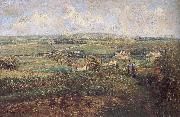Wholesale Oil Painting No Minimum |
|||||||||||
|
|
|||||||||||

|
|||||||||||
|
|
|
||||||||
Camille PissarroCaribbean-born French Pointillist/Impressionist Painter, ca.1830-1903 .Painter and printmaker. He was the only painter to exhibit in all eight of the Impressionist exhibitions held between 1874 and 1886, and he is often regarded as the 'father' of the movement. He was by no means narrow in outlook, however, and throughout his life remained as radical in artistic matters as he was in politics. Thad?e Natanson wrote in 1948: 'Nothing of novelty or of excellence appeared that Pissarro had not been among the first, if not the very first, to discern and to defend.' The significance of Pissarro's work is in the balance maintained between tradition and the avant-garde. Octave Mirbeau commented: 'M. Camille Pissarro has shown himself to be a revolutionary by renewing the art of painting in a purely working sense; |
||||||||
|
|
||||||||
Rainbow
Rainbow Painting ID:: 60628 |
mk259 1877 Oil on canvas 53 x 81 cm mk259 1877 Oil on canvas 53 x 81 cm |
|||||||
|
|
||||||||
|
Alexei Savrasov Russian Painter, 1830-1897 was a Russian landscape painter and creator of the lyrical landscape style. Savrasov was born into the family of a merchant. He began to draw early and in 1838 he enrolled as a student of professor Rabus at the Moscow School of Painting, Sculpture and Architecture (graduated in 1850), and immediately began to specialize in landscape painting. In 1852, he traveled to Ukraine. Then, in 1854 by the invitation of the Grand Duchess Maria Nikolayevna, President of the Imperial Academy of Arts, he moved to the neighborhood of St. Petersburg. In 1857, Savrasov became a teacher at the Moscow School of painting, sculpturing and architecture. His best disciples, Isaac Levitan and Konstantin Korovin, remembered their teacher with admiration and gratitude. The Rooks Have Come Back was painted by Savrasov near Ipatiev Monastery in Kostroma.In 1857, he married Sophia Karlovna Hertz, sister of art historian K. Hertz. In their home they entertained artistic people and collectors including Pavel Tretyakov. Savrasov became especially close with Vasily Perov. Perov helped him paint the figures of the boat trackers in Savrasov's Volga near Yuryevets, Savrasov painted landscapes for Perov's Bird catcher and Hunters on Bivouac. In the 1860s, he traveled to England to see the International Exhibition, and to Switzerland. In one of his letters he wrote that no academies in the world could so advance an artist as the present world exhibition. The painters who influenced him most were British painter John Constable and Swiss painter Alexandre Calame. The Rooks Have Come Back (1871) is considered by many critics to be the high point in Savrasoves artistic career. Using a common, even trivial, episode of birds returning home, and an extremely simple landscape, Savrasov emotionally showed the transition of nature from winter to spring. It was a new type of lyrical landscape painting, called later by critics the mood landscape. The painting brought him fame. In 1870, he became a member of the Peredvizhniki group, breaking with government-sponsored academic art. In 1871, Rainbow Rainbow (1873). |
||||||||
|
|
||||||||
|
Prev Next
|
||||||||
|
|
||||||||
|
Related Paintings to Alexei Savrasov :. |
||||||||
|
|
||||||||
|
CONTACT US |

